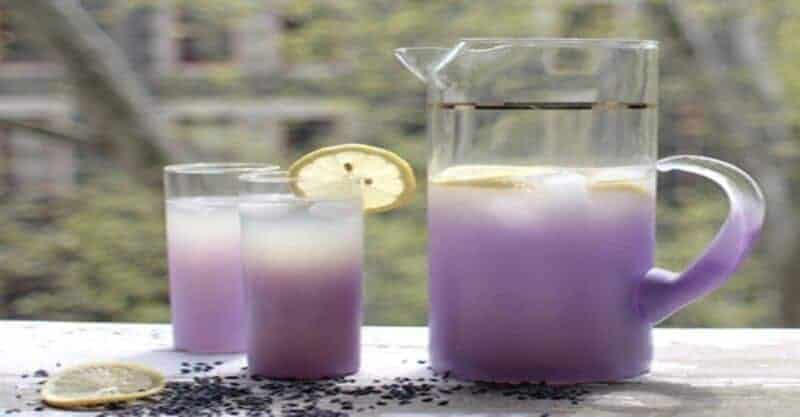Have you heard of Lavender lemonade drink? Then get prepared to tantalize your sense with this exquisite aromatic drink.
Not only its tastes and smells great but it has amazing health benefits too. If you haven’t tried, then go ahead DIY this lemonade for yourself.
Lavender Oil is an essential oil which has not only aromatic smell but also a healing herb which clams your senses.It has over 150 constituents which have active healing properties.
It has been used since ages as antibacterial, antimicrobial. Anti-Inflammatory, antidepressant, antiseptic, antibacterial, analgesic, hypertensive, detoxify and sedative properties.
In Ayurveda, Lavender oil has been used in reducing anxiety and stress. It soothes your senses and lowers your pulse rates.
This is a reason why lavender has been used in aromatherapy. A study has proved that it reduce depression, ease labor pains and cures insomnia.
Table of Contents
Health Benefits Of Lemon Are Known To Everyone
1. It boosts your immune system.
2. Helps in digestion.
3. Cleanse your system and flush out toxin out of your body.
4. Gives you blemish free clear skin.
5. Increases your energy.
6. Fights viral infection.
Lemonade is used to treat indigestion, throat infection, obesity, cholera, blood pressure, indigestion.
After knowing all the benefits associated with Lavender and Lemon, I think you will be convinced about drinking it.
This lemonade it most useful in case if you have a headache related to stress and anxiety. In case if you have headaches and anxiety then try this drink. This probably best natural way to cure headaches and anxiety.
DIY Lavender Lemonade
Ingredients
- 6 cups of water
- ½ cup of honey
- Juice extracted from 3 lemons
- 1 small drop of Lavender Oil
- Mix these ingredients and your drink is ready.
Alternatively, You Can Prepare It This Way Also
- ¼ cup of dried lavender flower
- Juice from 3 lemons
- 6 cups of water
- Sugar or Honey as per your desired. Add them as per your taste.
Boil 2 cups of water and add lavender to it. Boil it for 10 min and then extract lavender from it.Leave it for a while to cool it down. Mix honey (sugar), lemon juice to it. Your lemonade is ready.
Tell me how you find this recipe!
Reference
1. Buckle J. Use of aromatherapy as a complementary treatment for chronic pain. Altern Ther Health Med1999;5:42-51.
2. Bradley BF, Brown SL, Chu S, Lea RW. Effects of orally administered lavender essential oil on responses to anxiety-provoking film clips. Hum Psychopharmacol. 2009;24(4):319-330.
3. Kasper S, Gastpar M, Müller WE, et al. Silexan, an orally administered Lavandula oil preparation, is effective in the treatment of ‘subsyndromal’ anxiety disorder: a randomized, double-blind, placebo controlled trial. Int Clin Psychopharmacol 2010;25:277-287.
4. Woelk H, Schlaefke S. A multi-center, double-blind, randomised study of the Lavender oil preparation Silexan in comparison to Lorazepam for generalized anxiety disorder. Phytomedicine. 2010;17:94-99.
5. Azkhondzadeh S, Kashani L, Fotouhi A, et al. Comparison of Lavandula angustifolia Mill. tincture and imipramine in the treatment of mild to moderate depression: a double-blind, randomized trial. Prog Neuropsychopharmacol Biol Psychiatry. 2003;27(1):123-127.
65. Stange R, Schaper S, Uehleke B, Dienel A, Schlaefke S. Phase II study on the effects of lavender oil (Silexan) in patients with neurasthenia, posttraumatic stress disorders or somatisation disorder. Focus on Alternative and Complementary Therapies. 2007;12:46.
6. Tisserand R. Lavender beats benzodiazepines. Int J Aromather. 1988;1:1-2.
7. Woelk H, Kapoula O, Lehr S, Schröter K, Weinholz P. A comparison of Kava special extract WS 1490 and benzodiazepines in patients with anxiety. Healthnotes Review. 1999;6:265-270.
8. Bielski RJ, Bose A, Chang CC. A double-blind comparison of escitalopram and paroxetine in the long-term treatment of generalized anxiety disorder. Ann Clin Psychiatry. 2005;17(2):65-69.
9. Allgulander C, Hartford J, Russell J, et al. Pharmacotherapy of generalized anxiety disorder: results of duloxetine treatment from a pooled analysis of three clinical trials. Curr Med Res Opin. 2007;23(6):1245-1252.






